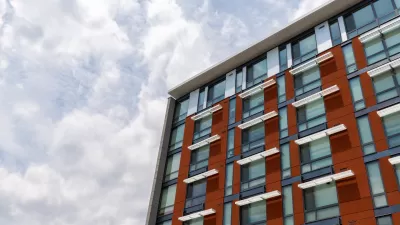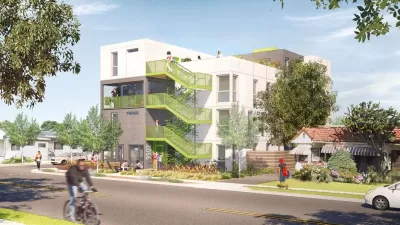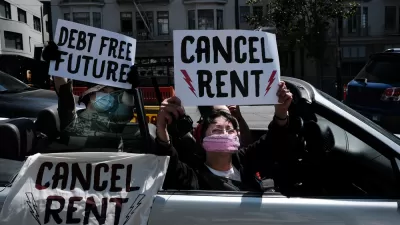Modular housing is cheaper and faster to build compared to conventional buildings. These advantages could make it an effective and viable way to increase apartment housing stock.

Matt Levin reports on developments in modular housing and its potential to bring down construction costs for larger buildings. A manufacturer in the San Francisco Bay Area assembles units offsite so the buildings can go up in days. "Picture one of those gigantic General Motors plants in Detroit, where a car is put together in an assembly line. Instead of a Buick and a conveyor belt, construction workers in hard hats and goggles are assembling a 156-unit apartment building for a development near Oakland," says Levin.
Levin also explores the history of pre-fab housing in the United States, including Operation Breakthrough, a federally funded $190 million initiative started in 1969 that eventually proved unsuccessful. "Much of the housing ended up being uninhabitable after a few years, adding to the public perception that factory-built housing was at best shabby, and at worst dangerous. Congress pulled the plug shortly after the prototype sites were completed."
Operation Breakthrough also could not achieve the necessary economies of scale, and today’s developers face the same challenge. With a focus on larger housing projects, rather than single-family homes, modular housing manufacturers hope that the market for mass-produced buildings will continue to grow.
FULL STORY: Can factory-built apartments solve California’s housing woes?

Alabama: Trump Terminates Settlements for Black Communities Harmed By Raw Sewage
Trump deemed the landmark civil rights agreement “illegal DEI and environmental justice policy.”

Study: Maui’s Plan to Convert Vacation Rentals to Long-Term Housing Could Cause Nearly $1 Billion Economic Loss
The plan would reduce visitor accommodation by 25% resulting in 1,900 jobs lost.

Planetizen Federal Action Tracker
A weekly monitor of how Trump’s orders and actions are impacting planners and planning in America.

Wind Energy on the Rise Despite Federal Policy Reversal
The Trump administration is revoking federal support for renewable energy, but demand for new projects continues unabated.

Passengers Flock to Caltrain After Electrification
The new electric trains are running faster and more reliably, leading to strong ridership growth on the Bay Area rail system.

Texas Churches Rally Behind ‘Yes in God’s Back Yard’ Legislation
Religious leaders want the state to reduce zoning regulations to streamline leasing church-owned land to housing developers.
Urban Design for Planners 1: Software Tools
This six-course series explores essential urban design concepts using open source software and equips planners with the tools they need to participate fully in the urban design process.
Planning for Universal Design
Learn the tools for implementing Universal Design in planning regulations.
Caltrans
Smith Gee Studio
Institute for Housing and Urban Development Studies (IHS)
City of Grandview
Harvard GSD Executive Education
Toledo-Lucas County Plan Commissions
Salt Lake City
NYU Wagner Graduate School of Public Service





























